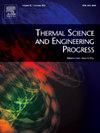Effect of concentration on the explosive reaction and mechanism of petroleum ether
IF 5.1
3区 工程技术
Q2 ENERGY & FUELS
引用次数: 0
Abstract
Petroleum ether is a kind of light hydrocarbon product produced in the petroleum refining process, which is not only used as organic solvent but also used in the preparation of fuel air explosive (FAE). Although petroleum ether has a wide range of industrial uses, its hazards of fire and explosion have not been fully studied. This study employs experiments combined with reactive force field molecular dynamics simulation to investigate the explosion dynamics and microscopic reaction mechanisms of petroleum ether. The results showed that the speed of flame propagation, the maximum explosion pressure, and the explosion index increased and then decreased with increasing the concentration. In the C6H14 explosion process, C6H14 first reacts with O2 to generate free radicals such as ·OH and ·HO2 through H-abstraction. These free radicals constantly participate in the chain reaction, forming dominant reaction channels and driving the pressure to rise rapidly. When the concentration reached 250 g/m3, excess fuel and insufficient oxygen limited flame development in locally rich fuel areas. These findings establish quantitative guidelines for explosion risk mitigation and provide mechanistic insights for designing next-generation FAE, enabling optimized fuel loading to maximize blast overpressure while suppressing incomplete combustion risks.
浓度对石油醚爆炸反应的影响及其机理
石油醚是石油炼制过程中产生的一种轻烃产品,不仅用作有机溶剂,而且还用于燃料空气炸药的制备。虽然石油醚具有广泛的工业用途,但其火灾和爆炸危险性尚未得到充分的研究。本研究采用实验与反应力场分子动力学模拟相结合的方法对石油醚的爆炸动力学和微观反应机理进行了研究。结果表明:随着浓度的增加,火焰传播速度、最大爆炸压力和爆炸指数呈先增大后减小的趋势;在C6H14爆炸过程中,C6H14首先与O2反应,通过h萃取生成·OH、·HO2等自由基。这些自由基不断参与链式反应,形成优势反应通道,带动压力迅速上升。当浓度达到250 g/m3时,燃料过剩和氧气不足限制了局部燃料丰富地区的火焰发展。这些发现为降低爆炸风险建立了定量指南,并为设计下一代FAE提供了机制见解,从而优化了燃料负载,最大限度地提高了爆炸超压,同时抑制了不完全燃烧风险。
本文章由计算机程序翻译,如有差异,请以英文原文为准。
求助全文
约1分钟内获得全文
求助全文
来源期刊

Thermal Science and Engineering Progress
Chemical Engineering-Fluid Flow and Transfer Processes
CiteScore
7.20
自引率
10.40%
发文量
327
审稿时长
41 days
期刊介绍:
Thermal Science and Engineering Progress (TSEP) publishes original, high-quality research articles that span activities ranging from fundamental scientific research and discussion of the more controversial thermodynamic theories, to developments in thermal engineering that are in many instances examples of the way scientists and engineers are addressing the challenges facing a growing population – smart cities and global warming – maximising thermodynamic efficiencies and minimising all heat losses. It is intended that these will be of current relevance and interest to industry, academia and other practitioners. It is evident that many specialised journals in thermal and, to some extent, in fluid disciplines tend to focus on topics that can be classified as fundamental in nature, or are ‘applied’ and near-market. Thermal Science and Engineering Progress will bridge the gap between these two areas, allowing authors to make an easy choice, should they or a journal editor feel that their papers are ‘out of scope’ when considering other journals. The range of topics covered by Thermal Science and Engineering Progress addresses the rapid rate of development being made in thermal transfer processes as they affect traditional fields, and important growth in the topical research areas of aerospace, thermal biological and medical systems, electronics and nano-technologies, renewable energy systems, food production (including agriculture), and the need to minimise man-made thermal impacts on climate change. Review articles on appropriate topics for TSEP are encouraged, although until TSEP is fully established, these will be limited in number. Before submitting such articles, please contact one of the Editors, or a member of the Editorial Advisory Board with an outline of your proposal and your expertise in the area of your review.
 求助内容:
求助内容: 应助结果提醒方式:
应助结果提醒方式:


